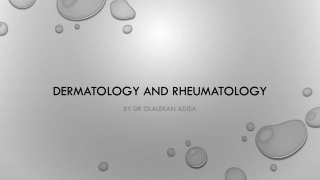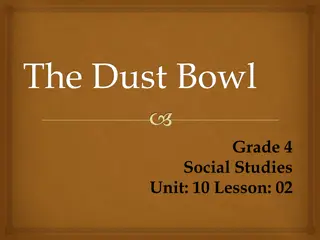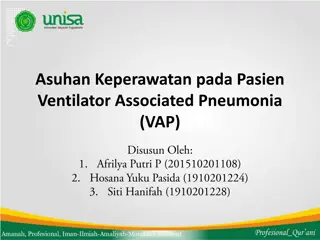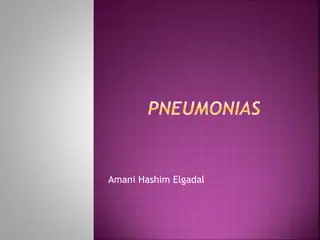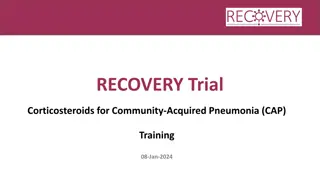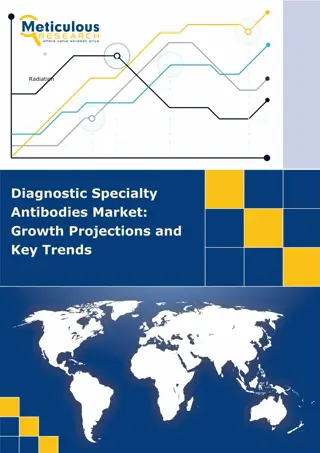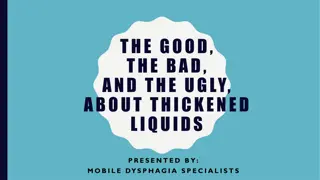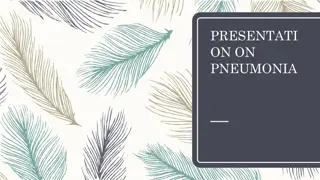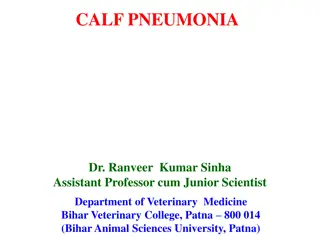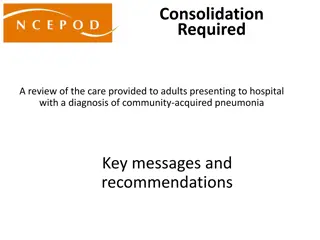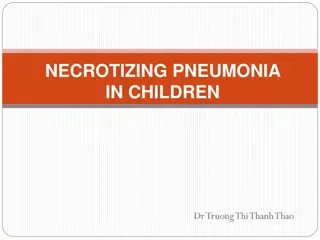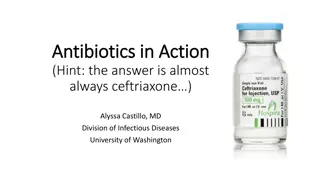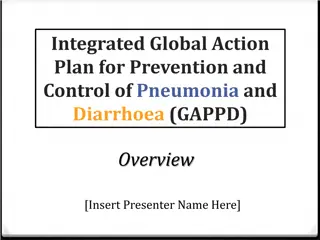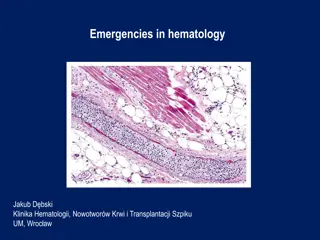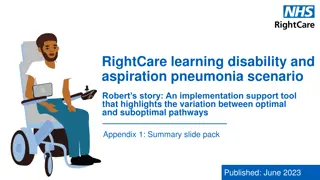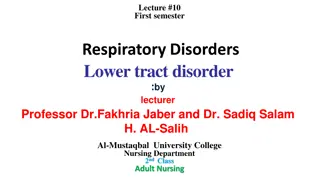
Pneumonia: Types, Symptoms, and Treatments
Explore the comprehensive guide on pneumonia, covering its definition, symptoms, types (including community-acquired and hospital-acquired), and precautions. Learn about the causes and treatment options for this lung infection.
Download Presentation

Please find below an Image/Link to download the presentation.
The content on the website is provided AS IS for your information and personal use only. It may not be sold, licensed, or shared on other websites without obtaining consent from the author. If you encounter any issues during the download, it is possible that the publisher has removed the file from their server.
You are allowed to download the files provided on this website for personal or commercial use, subject to the condition that they are used lawfully. All files are the property of their respective owners.
The content on the website is provided AS IS for your information and personal use only. It may not be sold, licensed, or shared on other websites without obtaining consent from the author.
E N D
Presentation Transcript
StudyMafia.Org Pneumonia Submitted To: Submitted By: Studymafia.org Studymafia.org
Table Contents Definition Introduction Symptoms of Pneumonia Types of Pneumonia Conclusion 2
Definition Pneumonia is an infection of one or both of the lungs caused by bacteria, viruses, or fungi. 3
Introduction It is a serious infection in which the air sacs fill with pus and other liquid. Lobar pneumonia affects one or more sections (lobes) of the lungs. Bronchial pneumonia (also known as bronchopneumonia) affects patches throughout both lungs. 4
Types of Pneumonia Hospital-acquired pneumonia. You catch this type during a stay in a hospital. It can be serious because the bacteria causing the pneumonia can be resistant to antibiotics. 6
Types of Pneumonia Hospital-acquired pneumonia. You're more likely to get this type if: You're on a breathing machine You can't cough strongly enough to clear your lungs You have a tracheostomy (trach) tube to help you breathe Your immune system -- your body's defense against germs -- is weak from a disease or treatment 7
Types of Pneumonia Community-acquired pneumonia. This is a fancy way of saying you got infected somewhere other than a hospital or long-term care facility. Community-acquired pneumonia can be caused by bacteria, viruses, and fungi. Vaccines can help protect against the flu virus and certain bacteria that can also cause pneumonia. 8
Types of Pneumonia Community-acquired pneumonia. Community-acquired pneumonia also includes aspiration pneumonia, which happens when you breathe food, fluid, or vomit into your lungs. It's more likely if you have problems swallowing or coughing. If you can't cough up the material you took in, bacteria can multiply in your lungs. 9
Types of Pneumonia Bacterial Pneumonia Bacteria cause most cases of community- acquired pneumonia in adults. You can catch pneumonia when someone who is infected coughs or sneezes. Bacteria-filled droplets get into the air, where you can breathe them into your nose or mouth. 10
Types of Pneumonia Bacterial Pneumonia Antibiotics treat bacterial pneumonia. Your doctor might do tests to find the type of bacteria that are causing your infection so you can get the right one. If you have community-acquired pneumonia, antibiotics that you take by mouth are usually enough to treat the infection. 11
Types of Pneumonia Bacterial Pneumonia You may notice symptoms like: A cough that brings up mucus Fever over 100.4 F Fast breathing Shortness of breath Chest pain Fatigue 12
Types of Pneumonia Walking pneumonia It is a less severe form of bacterial pneumonia. Sometimes, doctors call it "atypical" pneumonia. Symptoms can be so mild that you don't know you have it. You may feel well enough that you're able to go about your regular activities, which is where the "walking" in the name comes from. 13
Types of Pneumonia Walking pneumonia Symptoms Fever Cough Headache Chills Antibiotics treat the infection. You're likely to start to feel better in 3 to 5 days, but the cough can last a few weeks. 14
Types of Pneumonia Viral Pneumonia Viruses are the second most common cause of pneumonia. Many kinds cause the disease, including some of the same viruses that bring on colds and flu and the coronavirus that causes COVID-19. 15
Types of Pneumonia Antibiotics won't treat viral pneumonia, because they work only on bacteria. Treatment usually depends on the kind of symptoms you have. For example, if you have asthma or emphysema, you may need treatment to help with breathing. Drink extra fluids to help loosen mucus in your chest. 16
Types of Pneumonia Viral Pneumonia Symptoms Fever Chills Dry cough, which may get worse and make mucus Stuffy nose Muscle pain Headache 17
Types of Pneumonia Fungal Pneumonia Fungi are a less common cause of pneumonia. You're not likely to get fungal pneumonia if you're healthy. But you have a higher chance of catching it if your immune system is weakened. You get fungal pneumonia by breathing in tiny particles called fungal spores 18
Conclusion Pneumonia is an infection that inflames the air sacs in one or both lungs. The air sacs may fill with fluid or pus (purulent material), causing cough with phlegm or pus, fever, chills, and difficulty breathing. A variety of organisms, including bacteria, viruses and fungi, can cause pneumonia. 20
Thanks To StudyMafia.org

